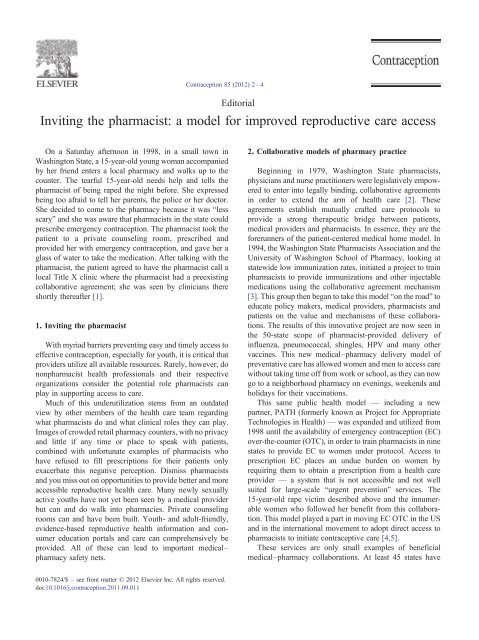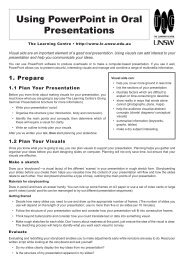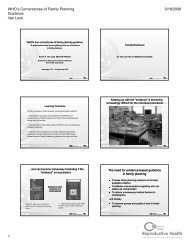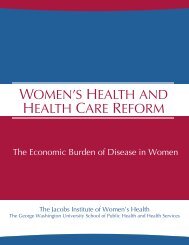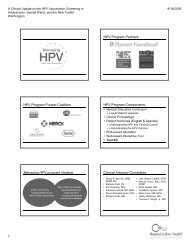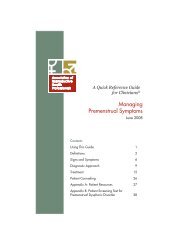Inviting the pharmacist: a model for improved reproductive care access
Inviting the pharmacist: a model for improved reproductive care access
Inviting the pharmacist: a model for improved reproductive care access
Create successful ePaper yourself
Turn your PDF publications into a flip-book with our unique Google optimized e-Paper software.
Contraception 85 (2012) 2 – 4Editorial<strong>Inviting</strong> <strong>the</strong> <strong>pharmacist</strong>: a <strong>model</strong> <strong>for</strong> <strong>improved</strong> <strong>reproductive</strong> <strong>care</strong> <strong>access</strong>On a Saturday afternoon in 1998, in a small town inWashington State, a 15-year-old young woman accompaniedby her friend enters a local pharmacy and walks up to <strong>the</strong>counter. The tearful 15-year-old needs help and tells <strong>the</strong><strong>pharmacist</strong> of being raped <strong>the</strong> night be<strong>for</strong>e. She expressedbeing too afraid to tell her parents, <strong>the</strong> police or her doctor.She decided to come to <strong>the</strong> pharmacy because it was “lessscary” and she was aware that <strong>pharmacist</strong>s in <strong>the</strong> state couldprescribe emergency contraception. The <strong>pharmacist</strong> took <strong>the</strong>patient to a private counseling room, prescribed andprovided her with emergency contraception, and gave her aglass of water to take <strong>the</strong> medication. After talking with <strong>the</strong><strong>pharmacist</strong>, <strong>the</strong> patient agreed to have <strong>the</strong> <strong>pharmacist</strong> call alocal Title X clinic where <strong>the</strong> <strong>pharmacist</strong> had a preexistingcollaborative agreement; she was seen by clinicians <strong>the</strong>reshortly <strong>the</strong>reafter [1].1. <strong>Inviting</strong> <strong>the</strong> <strong>pharmacist</strong>With myriad barriers preventing easy and timely <strong>access</strong> toeffective contraception, especially <strong>for</strong> youth, it is critical thatproviders utilize all available resources. Rarely, however, donon<strong>pharmacist</strong> health professionals and <strong>the</strong>ir respectiveorganizations consider <strong>the</strong> potential role <strong>pharmacist</strong>s canplay in supporting <strong>access</strong> to <strong>care</strong>.Much of this underutilization stems from an outdatedview by o<strong>the</strong>r members of <strong>the</strong> health <strong>care</strong> team regardingwhat <strong>pharmacist</strong>s do and what clinical roles <strong>the</strong>y can play.Images of crowded retail pharmacy counters, with no privacyand little if any time or place to speak with patients,combined with un<strong>for</strong>tunate examples of <strong>pharmacist</strong>s whohave refused to fill prescriptions <strong>for</strong> <strong>the</strong>ir patients onlyexacerbate this negative perception. Dismiss <strong>pharmacist</strong>sand you miss out on opportunities to provide better and more<strong>access</strong>ible <strong>reproductive</strong> health <strong>care</strong>. Many newly sexuallyactive youths have not yet been seen by a medical providerbut can and do walk into pharmacies. Private counselingrooms can and have been built. Youth- and adult-friendly,evidence-based <strong>reproductive</strong> health in<strong>for</strong>mation and consumereducation portals and <strong>care</strong> can comprehensively beprovided. All of <strong>the</strong>se can lead to important medical–pharmacy safety nets.2. Collaborative <strong>model</strong>s of pharmacy practiceBeginning in 1979, Washington State <strong>pharmacist</strong>s,physicians and nurse practitioners were legislatively empoweredto enter into legally binding, collaborative agreementsin order to extend <strong>the</strong> arm of health <strong>care</strong> [2]. Theseagreements establish mutually crafted <strong>care</strong> protocols toprovide a strong <strong>the</strong>rapeutic bridge between patients,medical providers and <strong>pharmacist</strong>s. In essence, <strong>the</strong>y are <strong>the</strong><strong>for</strong>erunners of <strong>the</strong> patient-centered medical home <strong>model</strong>. In1994, <strong>the</strong> Washington State Pharmacists Association and <strong>the</strong>University of Washington School of Pharmacy, looking atstatewide low immunization rates, initiated a project to train<strong>pharmacist</strong>s to provide immunizations and o<strong>the</strong>r injectablemedications using <strong>the</strong> collaborative agreement mechanism[3]. This group <strong>the</strong>n began to take this <strong>model</strong> “on <strong>the</strong> road” toeducate policy makers, medical providers, <strong>pharmacist</strong>s andpatients on <strong>the</strong> value and mechanisms of <strong>the</strong>se collaborations.The results of this innovative project are now seen in<strong>the</strong> 50-state scope of <strong>pharmacist</strong>-provided delivery ofinfluenza, pneumococcal, shingles, HPV and many o<strong>the</strong>rvaccines. This new medical–pharmacy delivery <strong>model</strong> ofpreventative <strong>care</strong> has allowed women and men to <strong>access</strong> <strong>care</strong>without taking time off from work or school, as <strong>the</strong>y can nowgo to a neighborhood pharmacy on evenings, weekends andholidays <strong>for</strong> <strong>the</strong>ir vaccinations.This same public health <strong>model</strong> — including a newpartner, PATH (<strong>for</strong>merly known as Project <strong>for</strong> AppropriateTechnologies in Health) — was expanded and utilized from1998 until <strong>the</strong> availability of emergency contraception (EC)over-<strong>the</strong>-counter (OTC), in order to train <strong>pharmacist</strong>s in ninestates to provide EC to women under protocol. Access toprescription EC places an undue burden on women byrequiring <strong>the</strong>m to obtain a prescription from a health <strong>care</strong>provider — a system that is not <strong>access</strong>ible and not wellsuited <strong>for</strong> large-scale “urgent prevention” services. The15-year-old rape victim described above and <strong>the</strong> innumerablewomen who followed her benefit from this collaboration.This <strong>model</strong> played a part in moving EC OTC in <strong>the</strong> USand in <strong>the</strong> international movement to adopt direct <strong>access</strong> to<strong>pharmacist</strong>s to initiate contraceptive <strong>care</strong> [4,5].These services are only small examples of beneficialmedical–pharmacy collaborations. At least 45 states have0010-7824/$ – see front matter © 2012 Elsevier Inc. All rights reserved.doi:10.1016/j.contraception.2011.09.011
Editorial / Contraception 85 (2012) 2–43legislation that enables <strong>pharmacist</strong>s and medical providers toenter into collaborative agreements [6]. These collaborations,when fully utilized, are a terrific example of how toestablish a patient-centered medical home that is inclusive of<strong>pharmacist</strong>s. Patients in traditional allopathic medicalpractices, not open on weekends or after hours, now haveimmediate <strong>access</strong> to contraceptive <strong>care</strong> and vaccinations.Think of patients who need <strong>access</strong> to <strong>the</strong>ir 3-month Depo-Provera injection or <strong>the</strong>ir second and third HPVvaccination, yet cannot get to a clinic during traditionalbusiness hours. Think also of a 20-year-old patient whoneeds EC on a weekend but <strong>the</strong> OTC product is out of reachfinancially. A <strong>pharmacist</strong> prescribing this EC ra<strong>the</strong>r thanselling it OTC can bill <strong>the</strong> patient's insurance without <strong>the</strong>patient deductible or co-pay [7].3. Barriers and solutions to <strong>access</strong>Access to <strong>reproductive</strong> and sexual health <strong>care</strong> isdetermined by many factors. Among <strong>the</strong> influences affectingboth consumers and providers are age, geographic location,personal <strong>reproductive</strong> health literacy, family, money,insurance, culture, religion, country, public policy, healthsystem fragmentation, provider time constraints, productavailability, local and national standards of <strong>care</strong>, peerpressure, <strong>the</strong> time of day, <strong>the</strong> day of <strong>the</strong> week and urgencyof need. Each of us has <strong>the</strong> ability to positively impact one ormore of <strong>the</strong>se <strong>access</strong> issues — <strong>pharmacist</strong>s are no exception.Uniquely placed in small towns and in inner cities, <strong>the</strong>irwalk-in <strong>access</strong>, <strong>the</strong>ir extended hours and <strong>the</strong>ir clinicaleducation put <strong>pharmacist</strong>s in a position to impact <strong>access</strong> to<strong>reproductive</strong> health in ways that may be inherently difficult<strong>for</strong> o<strong>the</strong>r providers to attain on <strong>the</strong>ir own.Successful pharmacy partnership solutions may involve,but are not at all limited to, <strong>the</strong> following examples:• Pharmacists engaged as consultant partners or asprofessional staff members/employees in <strong>reproductive</strong>health clinics and school-based health centers. Theseprimarily nondispensing pharmacy partnerships supportkey health messages to patients, assist ineliminating medication issues (i.e., refills, insurance,drug interactions, adherence, etc.) and help clinics tomeet or exceed <strong>the</strong>ir ever-increasing quality assurancerequirements [8].• Pharmacists, using collaborative agreements with localphysicians or Advanced Registered Nurse Practitioners,initiating hormonal contraception as a briefbridge <strong>for</strong> women without ready <strong>access</strong> to a medicalprovider [5]. Long-acting reversible contraception maybe <strong>the</strong> ultimate objective <strong>for</strong> many women, butcontraception initiated at <strong>the</strong> pharmacy may be avital temporary solution. Pharmacists using collaborativeagreement protocols with local medical providerscan establish <strong>for</strong>mal referral pipelines <strong>for</strong> cancer, rapeand sexually transmitted infection screenings, not tomention improving <strong>access</strong> to EC and hormonalcontraception pills, patches, rings and injectables.• Development of youth-friendly pharmacies to helpyouth <strong>access</strong> objective <strong>reproductive</strong> health in<strong>for</strong>mationand to help facilitate medical referrals. The PharmacyAccess Partnership program, supported by <strong>reproductive</strong>health visionaries such as Dr. Felicia Stewart,Dr. Jane Boggess, Belle Taylor-McGhee, Dr. PhilipDarney and Sharon Landau, among o<strong>the</strong>rs, has helpedus to better understand <strong>the</strong> <strong>reproductive</strong> health<strong>access</strong> needs of youth and <strong>the</strong> role that enlightened<strong>pharmacist</strong>s can play in removing <strong>access</strong> barriers.Advocates <strong>for</strong> Youth in Washington, DC, continuesthis work by embracing <strong>pharmacist</strong>s as key <strong>reproductive</strong>health partners.• Pharmacists providing Depo-Provera injections, asstated previously, after initial evaluation by a medicalclinician. HPV injections can similarly be provided,and <strong>the</strong>re may be additional opportunities <strong>for</strong> collaborationwith o<strong>the</strong>r important adherence medications.• Pharmacists stocking free or low-cost contraceptivesacquired from local clinics or by 340B purchasingagreements, a national medication discount programdesigned <strong>for</strong> patients of Federally Qualified HealthCenters. This <strong>model</strong> utilizes medical–pharmacy collaborativeprotocols to provide low- or no-costcontraceptive <strong>access</strong> to patients who are uninsured orunderinsured. Nonemancipated youth without <strong>access</strong>to <strong>the</strong>ir parent's insurance can also benefit by <strong>the</strong>sepharmacy partnerships. Low-income patients needingan urgent refill of <strong>the</strong>ir hormonal contraception orperhaps EC can <strong>access</strong> <strong>the</strong>se services under a specificprotocol even when <strong>the</strong>ir medical provider is temporarilyunavailable.• Pharmacists prescribing EC, under a collaborativeagreement protocol, to undocumented immigrants andwomen under 17 years of age needing a prescription<strong>for</strong> EC. Currently, this can only happen in <strong>the</strong> ninestates with <strong>pharmacist</strong> authority to initiate EC <strong>care</strong>services, but many o<strong>the</strong>r states could be added to <strong>the</strong>list. Pharmacists prescribing EC under a collaborativeagreement protocol to women 17 years of age andolder who technically have <strong>access</strong> to OTC EC butrequire EC to be prescribed <strong>for</strong> insurance coverage.With no co-pay <strong>for</strong> prescription contraceptives, thiswould eliminate cost barriers <strong>for</strong> many women.4. Conundrums, compensation and considerationsPharmacists, like o<strong>the</strong>r medical providers, have aninherent conflict of interest when <strong>the</strong>y simultaneouslyprovide clinical interventions, yet profit from <strong>the</strong> sale of<strong>the</strong>ir own medications. Un<strong>for</strong>tunately, <strong>the</strong> compensation<strong>model</strong> <strong>for</strong> <strong>pharmacist</strong>s is historically dependent on product
4 Editorial / Contraception 85 (2012) 2–4sales. Similar to <strong>the</strong> necessary change in medical providerpayment from procedure-based to patient outcomes-basedcompensation, <strong>pharmacist</strong>s must move away from productbasedcompensation in order to free <strong>the</strong>mselves of thisconflict of interest and to use <strong>the</strong>ir clinical education andexpertise to better effect.The collaboration opportunities outlined in this editorialare not limited to <strong>reproductive</strong> health <strong>care</strong>. Outcomes frommedical–pharmacy collaborations in diabetes, asthma,hypertension, heart disease, anticoagulation and o<strong>the</strong>rchronic problems are extremely encouraging <strong>for</strong> <strong>the</strong>ir effecton patient outcomes and health costs and <strong>for</strong> <strong>the</strong>ir positiveeffect on medicine's ability to meet quality assurancestandards [9–11].Pharmacy schools graduate <strong>pharmacist</strong>s not only wi<strong>the</strong>xtensive knowledge of medications but also with excellentknowledge of prevention-based interventions, chronicdisease medication management, management of patien<strong>the</strong>alth behaviors and patient counseling/education, all ofwhich are currently subjugated to filling one moreprescription in order to survive. Pharmacists engaged inbest <strong>reproductive</strong> <strong>care</strong> practices must find ways to balancetraditional dispensing obligations and embrace outcomesbasedincentives as part of a patient-centered health <strong>care</strong>team. Many new pharmacy graduates are considering<strong>for</strong>going any connection with prescription sales andpreparing to be <strong>the</strong> medication use provider on <strong>the</strong>ir diversehealth <strong>care</strong> team.It is not that <strong>pharmacist</strong>s can be and do everything; it isthat patients deserve better than what each of us can provideon our own. When <strong>pharmacist</strong>s are engaged as importantpartners, ra<strong>the</strong>r than dismissed as inconsequential (or worseas competitors or <strong>care</strong> obstructionists), history has shownthat women have greatly benefitted. When awareness, policyand leadership come toge<strong>the</strong>r, we can all participate increating radically new <strong>care</strong> delivery opportunities.ReferencesDon DowningDepartment of PharmacyUniversity of WashingtonBox 357630Seattle, WA 98195-7630, USAE-mail address: dondown@u.washington.edu[1] Consultation phone call to Don Downing by <strong>pharmacist</strong> during <strong>the</strong>patient encounter, 1998.[2] 1979 Revised Code of Washington (RCW) 18.64.011(23) and 1980Washington Administrative Code (WAC) 246-863-100.[3] Hogue MD, Grabenstein JD, Foster SL, Rothholz MC. Pharmacistinvolvement with immunizations: decade of postgraduate training.J Am Pharm Assoc 2006;46:168–82.[4] Wells ES, Hutchings J, Gardner JS, et al. Using pharmacies inWashington State to expand <strong>access</strong> to emergency contraception. FamPlann Perspect Special Report 1998;30:288–90.[5] Gardner JS, Miller L, Downing DF. Pharmacist prescribing ofhormonal contraceptives: results of <strong>the</strong> Direct Access Study. J AmPharm Assoc 2008;48:212–21.[6] American Pharmacists Association. Issue brief: collaborative drug<strong>the</strong>rapy management. Accessed from: http://www.<strong>pharmacist</strong>.com/AM/Template.cfm?Section=Home2&TEMPLATE=/CM/ContentDisplay.cfm&CONTENTID=16882.[7] DeNoon DJ. No more co-pay <strong>for</strong> birth control. WebMD. Accessed from:http://women.webmd.com/news/20110801/no-more-copay-<strong>for</strong>womens-wellness-birth-control.[8] Bunting BA, Smith BH, Su<strong>the</strong>rland SE. The Asheville Project: clinicaland economic outcomes of a community-based long-term medication<strong>the</strong>rapy management program <strong>for</strong> hypertension and dyslipidemia. J AmPharm Assoc 2008;48:23–31.[9] Patient-centered Primary Care Collaborative. The patient-enteredmedical home: integrating comprehensive medication management tooptimize patient outcomes. Accessed from: http://www.pcpcc.net/files/medmanagepub.pdf. Accessed 8-27-2011.[10] Nichol A, Downs GE. The <strong>pharmacist</strong> as physician extender in familymedicine office practice. J Am Pharm Assoc 2006;46:77–83.[11] Blumenthal D, Tavenner M. The “meaningful use” regulation <strong>for</strong>electronic health records. N Engl J Med 2010;363:501–3.


